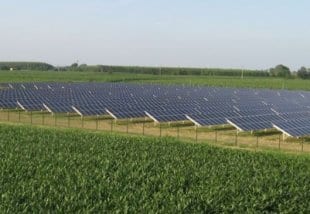 Last year, Romania installed more than 1 gigawatt of solar PV for the first time ever, putting the country into a tier that includes global players such as Italy, India, Greece and the United Kingdom. Developers had first begun to move into the Romanian market as incentives waned in historically large PV markets like Germany, Italy and Spain.
Last year, Romania installed more than 1 gigawatt of solar PV for the first time ever, putting the country into a tier that includes global players such as Italy, India, Greece and the United Kingdom. Developers had first begun to move into the Romanian market as incentives waned in historically large PV markets like Germany, Italy and Spain.
This year, the Romanian incentive program was stepped back on January 1, creating a rush in the market to install qualified projects before the end of the year. The Romanian market experience holds some important lessons about the past and the future of global demand for solar power.
How Romania became a gigawatt-scale market
This past year marked a major shift in the global solar market as demand dispersed from Western Europe to the Asia-Pacific region and the United States. Incentives in traditional PV markets such as Germany, Spain, Italy and the Czech Republic have been minimized or abolished, and established developers eager to build have searched for new markets with the right conditions to deliver solid returns.
Enter Romania.
In 2013, the Romanian incentive structure entitled project developers to a total of six green certificates per megawatt-hour of electricity produced. These certificates could be traded on a spot market at a floor of €27 per megawatt-hour and a ceiling of €55 per megawatt-hour, with an annual upward adjustment to account for inflation. A condition of undersupply kept certificate prices well above the floor, and developers flocked to the country, drawn by the attractive returns no longer available in established European markets.
Demand significantly exceeded expectations, and in response, the Romanian Energy Regulatory Authority (ANRE) recommended a reduction in green certificates from six to three in March 2013. However, the Romanian government instead announced that beginning in July, two of every six green certificates would be withheld until March 2017, in the hopes that this course of action would curtail PV demand.
Instead, spot prices for green certificates remained in the €40 to €45 per megawatt-hour range for the second half of the year, and installations continued at a rapid pace. When ANRE and the government finally announced that a cut from six green certificates per megawatt-hour to three would apply to any project completed after January 1, a massive rush of projects came on-line in order to beat the deadline.
The result? A 3,667 percent increase in solar installations over the 30 megawatts installed in 2012.
What was left behind?
Romania and its Eastern Europe neighbors are home to oversupplied electricity markets and are not expected to reintroduce incentive programs for large-scale PV development. In Romania, expectations for 2014 are modest, with perhaps a few hundred megawatts of projects coming on-line that were unable to be completed prior to the cutoff date. A feed-in tariff is expected to be introduced this year for small-scale PV, and as a result, the market will most likely shift from large utility projects to residential and small commercial systems.
Romania will likely lower the mandatory green certificate buying quota for electricity distributors and large consumers as a result of exceeding its 20 percent renewable energy target. In order to protect both solar power producers and ratepayers who ultimately pay the costs of meeting the quotas, ANRE is likely to implement a price freeze on green certificates. Electricity prices in Romania are among the lowest in Europe, and accordingly, large consumers are extremely sensitive to the price fluctuations of the green certificate market.
The future of PV deployment in Romania
Romania’s rise is a byproduct of the longstanding forces governing PV demand, which shifted development from region to region based on rapid changes to incentives. With an attractive incentive program, acceptable insolation and geographic accessibility for vendors and EPCs, Romania met all the criteria for a strong PV market. But similar to other markets, a rapid phase-out of incentives caused a significant drop in installations.
Although this story of incentive-driven growth has been common in market development to date, the improving economics of solar will drive more interest in sustainable markets where incentives may be minimal but steady. While the stability of a government- or utility-backed revenue stream is highly desirable, retroactive feed-in tariff cuts in European markets show that it also comes with policy and regulatory risk. Developers will always chase after the next big incentive market, but expect more to shift their attention to emerging sustainable markets with higher insolation and growing energy demand, such as Latin America.
Source: GreenTech Media. Reproduced with permission.








